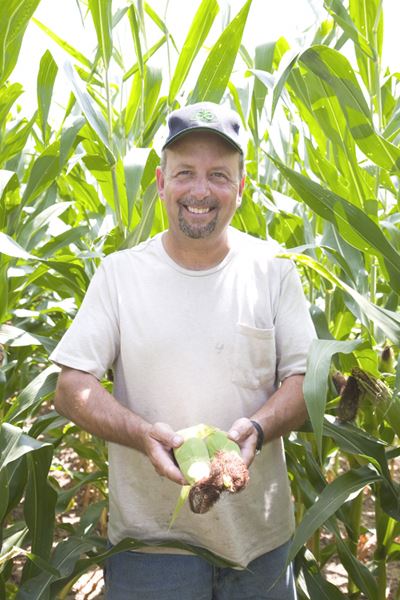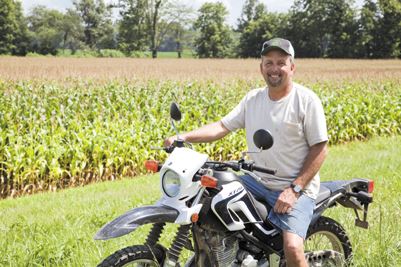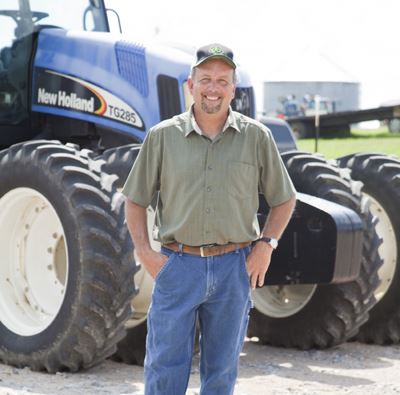Conserve Soil Moisture
Bigger Harvests Result From Modern Day Technology
HICKMAN CO., KY.
Cover crops, poultry litter and intense management spell success for
Davie Stephens of Hickman County, Ky, who, along with his father, Jimmy,
farms 6,000 acres. The duo focuses on raising corn and soybeans and
have diversified with a poultry operation.
The Stephens name has been almost synonymous with farming in this
area. Davie’s father Jimmy began work at a tire plant as a young man,
married his mother, Waynell, a factory worker, and they bought a
100-acre farm. He continued working at the tire plant for 13 years, then
became a full-time farmer in 1975.
“He said one of the hardest days of his life was wondering how he was
going to feed two kids, my mother and himself without a weekly
paycheck,” Davie recalled. However he continued to buy farms through
the ‘70s and into the ‘80s and ‘90s.
Davie helped with the operation and also did accounting work in the
winter when he returned from University of Kentucky in 1988 with a
bachelor’s degree in agricultural economics with a specialization in
finance.
“My father really didn’t need me and probably couldn’t afford me, but
we had 150 cows,” he recalled. “I bought my first farm in 1988, started
farming, had cattle, got into the poultry business, and later my father
also entered into the poultry business.”
It was the introduction of a poultry plant in the area that spurred
their interest in poultry. That also led to their use of poultry litter
to fertilize their crops.
Davie was running cattle, and he worked in accounting a couple of
winters just to have some income. That helped his father because he
really wasn’t farming that much and it also helped Davie.
“Over the years we’ve grown, we still farm separately but we farm
together, and it truly doesn’t matter; if a field is ready, whichever
one is first on the way there, fine, we treat it as one. I can use any
tractor or combine he has and he can use any of mine. You would never
know we aren’t a partnership,” he said.
Back in the 1970s, few soybeans were grown in this area. Farmers
focused on corn and a little cotton as there were several gins in the
area.
All that has changed. With 6,000 acres between them, they no longer have cattle, just poultry barns, corn and soybeans.
“Since 1991, We’ve used the litter from the poultry barns for
fertilizer,” Davie explained. “We also buy a large amount of poultry
litter. We try not to use any commercial fertilizer. We get a better
response from the poultry litter. We do not produce enough litter
ourselves, so we buy from others. Back in the 1990s, no one wanted to
bother with poultry litter. We saw the need and learned its value
through the adaptation.”

Davie Stephens of Hickman County, Kentucky discusses how cover crops, poultry litter and intense management spells success.
Photos by John LaRose, Jr.

Davie Stephens of Hickman County, Kentucky

Davie Stephens of Hickman County, Kentucky
They began 100 percent no-tilling in 1992. They had no-tilled in the
late 1970s and 1980s and today they don’t even have tillage equipment.
Stephens farms creek bottoms, and has a little of Memphis, a little
loam and some Calloway. He sprays the bottoms down in the fall, and
finds that to be the best tillage tool.
“Spray in the fall and use Leadoff,” he said. “We don’t spray our
hills because we don’t want to take a chance on erosion. We have
waterways in place everywhere and I like good cover. We began using
cover crops when EQUIP was introduced by the NRCS.”
He soon saw the value of cover crops and began using cereal rye. Several farmers in the area are even using radishes.
“They will bust up the ground if you have a hard pan, so you don’t
have to do tillage,” Davie noted. “We just bought a farm in Tennessee a
few years ago, 200 acres, and it had compaction problems; we considered
deep till. But why deep till just to work it down? So we started
no-tilling and using cereal rye there. We truly believe in cover crops
for the erosion factor, but also to build the soil tilth.”
Stephens uses a vendor who does soil testing. The Stephens’ farms
range throughout a 17-mile radius. “We vary our rates on fertilizer.
Even with the poultry litter, we still have to supplement with some
commercial.
Supplements may not have been needed back in the early to late 1990s,
but with the expansion to producing large volumes of grain it takes
more out of the soil.
“We have our soil tested to make sure pH levels are good, and we’re
seeing the levels have increased a lot from using poultry litter since
the poultry litter has a lot of calcium,” Davie said. “We really see a
benefit from that. But we supplement with P&K, and we use nitrogen
in the form of anhydrous every year. We pre-plant anhydrous, because
it’s hard to sidedress on 20” rows. If you’re in 30” it’s great. It’s
truly the best time to put it on. But a lot of the farmers who use 30”
rows have gotten away from that too. They use a lot of the pre-plant and
some of them are using nitrogen stabilizers to help retain the nitrogen
in the soil.”
Stephens hires someone to spread the chicken litter dry with a
spreader truck. While he has his own spreader truck it’s used only for
odds and ends.
“If someone’s truck goes down and they’re trying to spread litter,
they’ll come borrow ours. We usually hire that 100 percent custom,” he
explained.
The going rate for chicken litter is two tons per acre. If the soil
needs to be built a little more can be used, but they try to keep it at
two.
“One reason we keep it at two is we would rather have some on every
farm with the shortage of it,” he said. “We find it better to short it
and be able to get over all the ground, and then supplement it with the
commercial. If we could put enough poultry litter on some of these farms
we wouldn’t have to supplement with the P&K, but we would have to
go to such a high rate that some farms wouldn’t get any that year.”
Stephens does a lot of testing for Pioneer, planting side-by-side trials.
“I do impact plots with my Pioneer agronomist, and I also do a pretty
intensive soybean plot and corn plot with my local rep,” he said. “We
gather the data and that helps them at the end of year. We probably are
70 percent or 75 percent Pioneer corn, probably 60 percent to 65 percent
Pioneer soybeans, and then we also plant some of the others. There’s
good and bad with every company, be it chemical or whatever, but Pioneer
is a major leader in their technology.”
Stephens likes to cut his own test plots, because he’s interested not only in yield, but in how it stands.
“When you get into that yield environment, especially with the corn,
it has to be resilient to stand. When you throw out a high population
and a high amount of fertilizer under it you go into a different playing
field of how that plant reacts. Can it take wind? How is it going to
produce? Is it going to be more disease prone? How is it going to act to
the daylight? So one reason I’m big on doing my own farmstock is so I
can see how it looks in my environment. I get emails from Pioneer, and
most other manufacturers, on how their products have done. But its hard
for me to compare my crop to someone’s that’s in 30” rows. I can get a
good look and see if there are any similarities, but if that population
is in 30” rows at 30,000 or 28,000, or if it was conventional and I’m
no-till, that’s really not comparable with mine. That’s why I like doing
my own testing.”
One of the big benefits he’s seen from the DuPont Pioneer products is high yields.
“Pioneer has always yielded good in our farming operation. We grow
20” row corn and we use a high population seed count. Corn would be
36,000, soybeans not as much. When you’re raising early beans you may
sow 180 or 190 seeds per acre, and then you’ll back that off, but with
the corn we go with the high populations. With that, though, you can put
as many plants out there as you want but if you don’t feed it, it won’t
do anything. It just needs a little more nitrogen to bring those levels
up to provide for what you’re hoping to pull off of that. I never plant
for a drought but we try to maximize what we have. We know the history
of our fields.”
Stephens uses a lot of Pioneer 1319, 0912, 2088, and 1412.
“They change numbers so much I almost have to refer back to my book,
but I know those are dominant players here,” he said. “As far as the
soybeans, I like 93Y92, 94Y23, 94Y40, and a few 95Y10. Actually we
planted 50 bags of two of the new they’ll be bringing out, this T
Series. So I am anxious to see how that works out, I don’t have any idea
what the number is, I’d have to go to the monitor to look it up but
it’s like a 4.6 or 4.7 soybean. I’m interested to see what’s coming
along on the pipeline with their Y series which really took our soybean
yields to another level. That really shifted me.”
Before the Y series Stephens really wasn’t heavy on Pioneer. It was in his rotation, but not like the Y Series.
“The Y Series really brought those guys to the table. I’m anxious to
see what the T Series is going to be. In a year like this, it’s
challenging because I just want to be planting; I don’t need to be
planting a plot that takes just two or three hours; but I am so proud of
it when we cut it in the fall and I can sit with my Pioneer rep or the
Pioneer agronomist and say ‘here’s what this did’ and we get a good look
at it.”
Stephens doesn’t irrigate, but the water table in the area helps tremendously
“We try to manage our risks through insurance,” Davie said. “We’ve
been taking crop insurance at different levels since 1999. It was ironic
because the first year we used crop insurance there was a drought. So
what better sell than a drought year? It makes you really appreciate it
as opposed to taking it for two or three years and not getting anything
out of it. So we manage our risk that way.”
Irrigation is a huge investment and monitoring challenge especially
with so many acres to monitor. He finds that his cover crops preserve
the moisture and allow the no-till and chicken litter to remain on the
soil. That, plus the insurance provides moisture security.
Stephens is concerned about the farm bill. He was in Washington
recently when the American Soybean Association met. They visited with
congressmen and offered the soybean association’s priorities.
“I know I would feel a lot better if we could have a farm bill in
place,” he said. “People really don’t notice the farm bill as much
whenever things are going good and commodity prices are good, but it’s
very important when you see $3 or $4 corn or $6 to $7 soybeans; and the
markets are starting to do that right now. It has really changed from
what it was a year ago.”
He diversifies his crops about 50/50 between corn and soybeans. He
tries to do a 100 percent rotation, except for those times when land
slated for corn remains too wet to plant in time. He took wheat out of
the rotation about 1995.
“We found the value of getting some early maturity soybeans planted
in April, we get such a higher yield out of that crop as opposed to the
wheat,” Stephens explained.
One reason he likes the early beans is because normally harvest is
about Aug. 15-20, at the very time the poultry barns need to be cleaned.
“We are able to rebed and get a flock of poultry in to take us
through the winter,” he said. “That way the gas company doesn’t take up
residence at the poultry barn. They would be putting in propane
non-stop. Plus, you have all your fertilizer on the farm. We don’t
always get it completed but I’m a big believer in getting the work done
way ahead of time. It’s not a very good feeling when you’re going across
the field to plant and the fertilizer truck is just in front of you.
That doesn’t happen often, but it can happen, mostly when it’s dictated
by weather.
“Back in 1988-89, I was just hoping for 110 bushel corn and 30 bushel
soybeans,” he recalled. “To be very conservative, I’d look for 100 for
corn and 25 for soybeans. Now we have our averages for corn in the
160-175 range and about 45-50 for soybeans. That’s how it has increased
the past 25 years.”
Input costs also have changed. Stephens paid about $150 a ton for his
first tank of anhydrous, whereas today that cost is about $650 a ton.
The same for seed, especially since years ago everyone saved their own
seed.
“You took $5 or $6 soybeans and had them cleaned and I think you had
$10 a bag in them; now that’s $50 or $60 a bag with the technology,” he
compared. The first corn I ever bought I think I paid $58 or $59 a bag
and now I’m paying $250 to $300; but that has brought that yield up over
those 25 years.
Stephens has had his battles with resistance and has worked through that with different chemistries as they were available.
“The resistant weeds just were more manageable,” he reported. “I
think the introduction of marestail in this area came about in 2001 or
2002. The first year it was difficult to control, you had to learn how;
we relied on some of our friends from Tennessee and we’ve learned a lot
from their experience. After that second year, marestail is not as much
of an issue anymore. It’s not hard to control, but it’s expensive as
compared to previous methods.”
The resistant weed on everyone’s mind is Palmer Amaranth. Davie follows the efforts of a farmer friend to stay ahead of it.
“He keeps up with all the chemistries. I used to know them all before
Roundup, but now I have to relearn them because I forgot that. One of
the main things my friend told me is ‘you have a big advantage I don’t
have;’ I asked him what that meant and he said ‘you can rotate your
crops.’”
Crop rotation does help control the Palmer Amaranth. Davie’s friend
can’t rotate, because he farms in the Mississippi river bottoms not
protected by the levee.
While he regularly considers whether he should add something to the
herbicide mixture and makes adjustments from year to year, Stephens also
watches the new Dicamba mixtures and other products that are awaiting
EPA approval. Still he finds the cover crops suppress a lot of weeds.
“They’re not already a foot tall when you’re trying to take them
down,” he said. “I hope that we can get some of that new herbicide
technology approved, because if we can, it will save a lot of farmers
from disking the problem weeds down. I don’t have to do that, and that
is better all around to prevent nutrients from going into the creeks.
Environmentally it’s friendlier, so hopefully that will be resolved with
the approval of the new technologies.”
Stephens urges farmers to pay attention and get involved in organizations both politically and production-wise.
“With checkoff, a lot of money is being reinvested in agriculture by
the different commodity groups and I’m a firm believer that those groups
have done some great research with these things,” he said. “Who ever
would have thought of the different uses for corn, and especially
soybeans, that the checkoff has shown us; from increasing trade with
exports to uses such as soy diesel, dog food, soy candles and soy foam
for use in Ford cars. The more we can promote our product and find new
uses for it, the better it is. We grow the safest, most abundant food
supply in the world and we do not need to take second place. I’m a firm
believer in that.”∆
BETTY VALLE GEGG-NAEGER: Senior Staff Writer, MidAmerica Farmer Grower